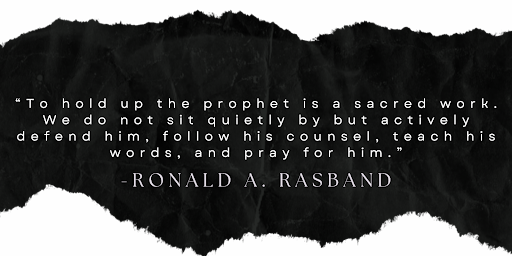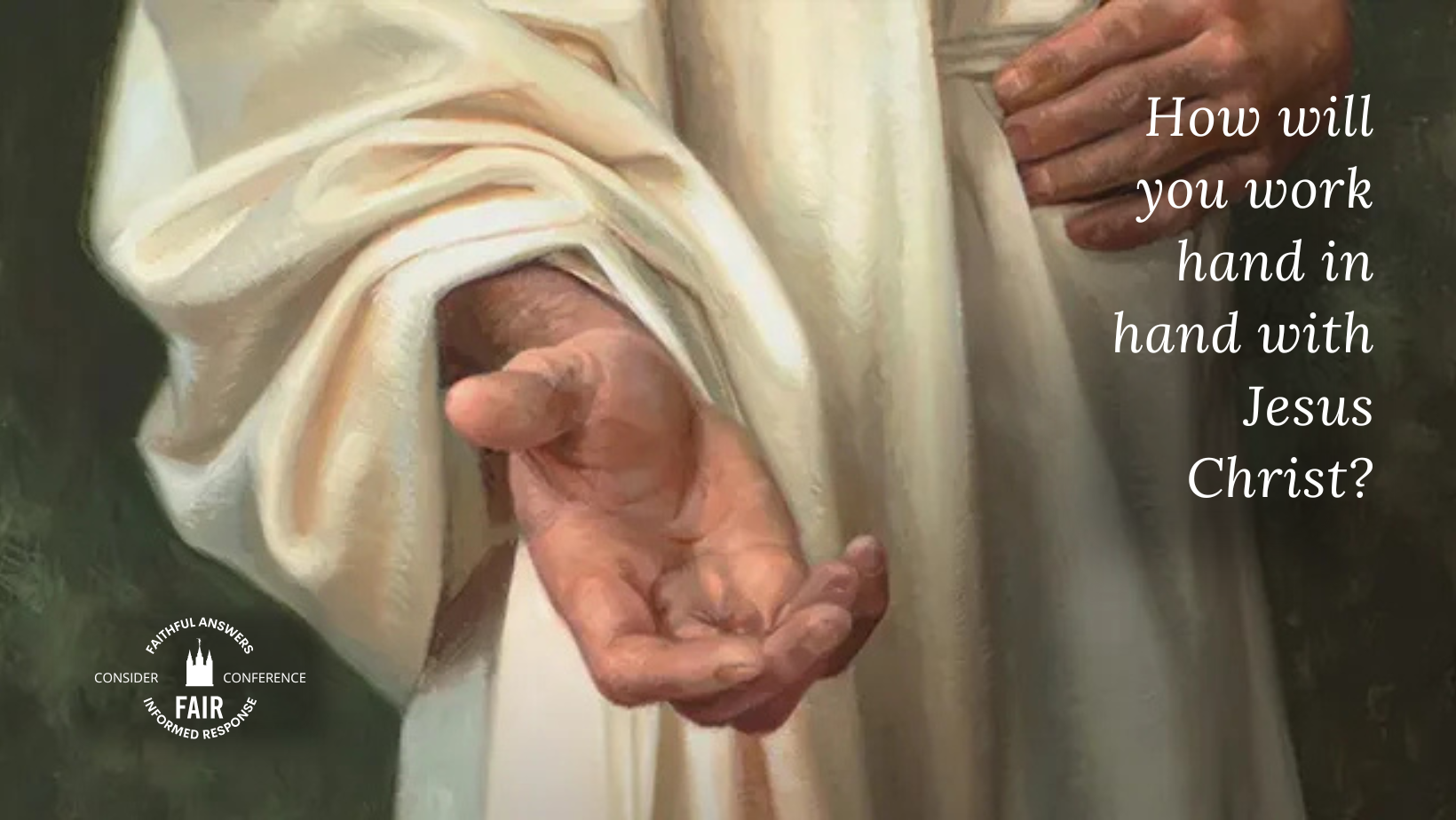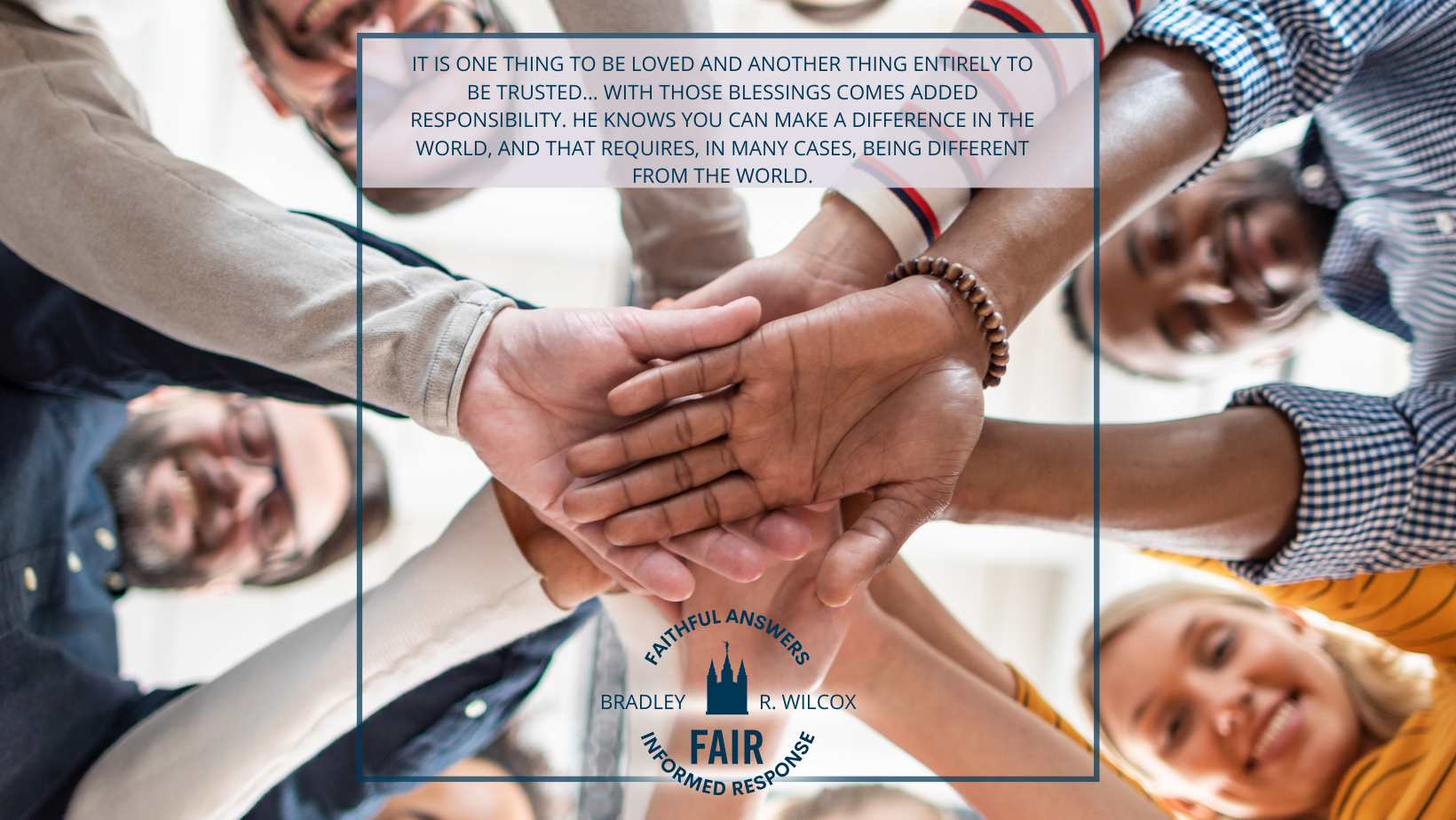“Why are Latter-day Saints so different?” This is a question many young members of the Church find themselves facing. In a world that values conformity, living differently can feel daunting, even isolating.
In his talk, “O Youth of the Noble Birthright”, Brother Brad Wilcox speaks to the youth of the Church, reminding them of their noble birthright as covenant children of God. He emphasizes that this identity calls for a distinct way of life, not because they are better than others but because they have a greater purpose to fulfill. Brother Wilcox’s words don’t just offer comfort but also a deeper understanding of how living differently aligns with God’s trust in His children and how it impacts their divine mission. This talk speaks directly to questions of identity, purpose, and divine trust, making it relevant for anyone encountering questions about faith, doctrinal beliefs, or the demands of discipleship.
Common Questions, Misconceptions, and Criticisms
Doctrine
- Why do Latter-day Saints believe God is a corporeal being?
- Response: Latter-day Saints believe that God is a glorified, resurrected, corporeal being, based on the scriptural teachings that God created man in His image (Genesis 1:27) and the accounts of God appearing in tangible, physical form to prophets, such as Joseph Smith’s First Vision (Joseph Smith—History 1:17). This view of God as having a body of “flesh and bones” (Doctrine and Covenants 130:22) distinguishes the LDS faith from traditional Christian views of the immaterial Trinity but aligns with early Christian understandings of God as a personal, physical being. (One key figure is Irenaeus of Lyon, a second-century Church Father, who in Against Heresies (Book 5, Chapter 6), affirmed the belief in the resurrection of the physical body and emphasized the material nature of God’s creation, pointing to the glorified, physical body of the resurrected Christ as the model for believers. Irenaeus argued that believers would inherit a transformed, glorified body like Christ’s. Additionally, Tertullian (160–225 AD), in Against Praxeas (Chapter 7), taught that God the Father had a physical form by saying, “For who will deny that God is a body, although God is a spirit?” Tertullian argued that although God is spirit, He possesses a material, tangible body, aligning with Latter-day Saint teachings on God’s corporeality.)
- Common Bias/Fallacy: The straw man fallacy is often present in criticisms of this doctrine, where critics misrepresent the LDS belief as reducing God to a limited, human-like form, rather than recognizing the glorified, divine nature of His corporeal body. Additionally, critics may display confirmation bias, favoring evidence that supports the traditional Christian view while ignoring early Christian beliefs that God had a body.
- Resources:
Doctrine and Covenants 130:22: God’s Nature as a Resurrected Being
- How can humans aspire to be like God? (Theosis/Deification)
- Response: The belief that humans can become like God, known as theosis or deification, is rooted in both Latter-day Saint doctrine and early Christian teachings. The Book of Mormon and Doctrine and Covenants teach that through Christ’s atonement, humans can progress eternally and inherit divine attributes (2 Nephi 2:25, Doctrine and Covenants 76:58). This belief is supported by biblical passages such as Romans 8:16–17, where Paul refers to believers as “heirs of God” and “joint-heirs with Christ.” Early Christian theologians like Irenaeus also spoke of theosis as a divine goal for humanity.
- Bias/Fallacy: Critics often commit the appeal to tradition fallacy by assuming that mainstream Christian interpretations of salvation are the only correct ones, ignoring early Christian teachings on deification. Additionally, the slippery slope fallacy may be invoked when critics assume that the LDS teaching leads to polytheism, which misrepresents the doctrine’s focus on exaltation through Christ’s grace.
- Resources:
Romans 8:16–17: Theosis and Early Christianity
- Why does the Church place so much importance on family ties?
- Response: The Church of Jesus Christ of Latter-day Saints teaches that family relationships are central to God’s plan of happiness. Families provide a foundation for personal growth, moral teaching, and spiritual development. The importance of the family is emphasized in the doctrine of eternal families, where members believe that family ties, when sealed by proper priesthood authority, can continue beyond death (Doctrine and Covenants 132:19–20). This view is rooted in the doctrine that God’s work and glory are to bring about the eternal life of His children, and family units play a key role in that eternal progression.
- Bias/Fallacy: Critics often employ the false dichotomy fallacy by assuming that focusing on family ties excludes love or service to others outside the family, whereas LDS doctrine emphasizes that strong families are a way to strengthen communities and fulfill God’s plan for all of His children.
- Resources:
The Family: A Proclamation to the World: Why Families Are Central in God’s Plan

Defending Divine Doctrines
Doctrinal Emphasis:
Brother Wilcox’s talk emphasizes the birthright and covenant relationship of the youth. By entering covenants, members of the Church gain access to divine privileges, setting them apart not for superiority but for service. The Plan of Salvation explains this divine potential: that as children of God, members are entrusted to grow, progress, and participate in God’s work on Earth.
Application:
Teachings like the Plan of Salvation and covenant relationships serve as powerful tools to clarify questions and affirm that these doctrines are based on God’s eternal love and His desire for His children to grow and serve with purpose.
Historical and Doctrinal Connections
Contextual Background:
Brother Wilcox touches on the idea of birthright, which historically in the Old Testament carried added responsibility. The birthright son stayed to take care of the family and inherited greater blessings as a result. Today, this can be seen as a metaphor for the responsibilities of discipleship. In the context of the Church, young members are reminded that they are responsible for preserving and sharing their faith and helping others along the way.
Resources for Deeper Understanding:
- Plan of Salvation: FAIR: Plan of salvation
- Eternal Families and Covenant: Resources on why family relationships and covenants are central to the LDS faith. Why Is Family So Important? Why Ordinances and Covenants Matter
Living Apologetics
Practical Application
Brother Wilcox encourages youth to live distinctly because they have made covenants with God. Here are a few ways this talk inspires real-life application:
- Respectful Dialogue Guide: When discussing LDS beliefs about God, eternal families, or doctrinal uniqueness, it helps to emphasize understanding over defensiveness.
- Faith in Action:
- Start conversations about birthright responsibilities and how they impact daily choices.
- Share insights on what it means to be a child of the covenant in family home evenings or youth group discussions.
- Journal your reflections on living as a covenant child of God and how that deepens your understanding of discipleship.
Quick Reference: Key Defenses and Facts
Defensive Highlights:
- Birthright: This is not just about privilege but about stewardship and serving others.
- Divine Potential: Early Christian texts also taught about becoming like God; this is not a uniquely LDS doctrine. Read more about becoming like God here.
- Nature of God: LDS beliefs are grounded in scripture that portrays God as a loving, perfected, and personal Being. Learn more about this understanding of the nature of God here.
Top Apologetic Facts:
- The doctrine of Theosis aligns with early Christian thought.
- Eternal Families are not exclusionary but are meant to extend the concept of eternal love and connection.
- The Plan of Salvation includes everyone in God’s family, not just Latter-day Saints, and is a message of inclusivity and divine hope.
Conclusion
Encouragement and Reflection:
The unique aspects of Latter-day Saint teachings provide clarity and comfort, even in a world that may not always understand. Brother Wilcox’s message is a powerful reminder of the privilege and responsibility that comes with being a child of the covenant. How can you better embrace your birthright and work hand in hand with Jesus Christ? Consider exploring more FAIR articles on related topics to deepen your understanding and strengthen your commitment.
For further exploration, click here to access more FAIR resources on these and other important topics.

“As you fulfill your birthright responsibilities, you are never alone. The Lord of the vineyard labors with you. You are working hand in hand with Jesus Christ. With each new covenant—and as your relationship with Him deepens—you hold each other tighter and tighter until you are firmly clasped together… ‘O youth of the noble birthright, carry on, carry on, carry on!’ I testify that you are loved—and you are trusted—today, in 20 years, and forever. Don’t sell your birthright for a mess of pottage. Don’t trade everything for nothing. Don’t let the world change you when you were born to change the world.” – Brother Bradley R. Wilcox
Share your insight
Your thoughts and experiences can help others along their journey. Share them below, and let’s continue this conversation on sustaining the Savior’s light together.
The Consider Conference series by FAIR offers an in-depth look at recent General Conference talks to help members of the Church of Jesus Christ of Latter-day Saints navigate common questions, misunderstandings, and criticisms. Each post provides doctrinal insights, historical context, and practical ways to apply gospel principles in everyday conversations. Through this series, we hope to equip readers with faith-promoting resources that encourage thoughtful reflection, respectful dialogue, and a stronger foundation in gospel truths, fostering both personal conviction and meaningful discussions with others.
The post Living as Children of the Covenant: Understanding Our Birthright and Responsibility appeared first on FAIR.
Continue reading at the original source →





